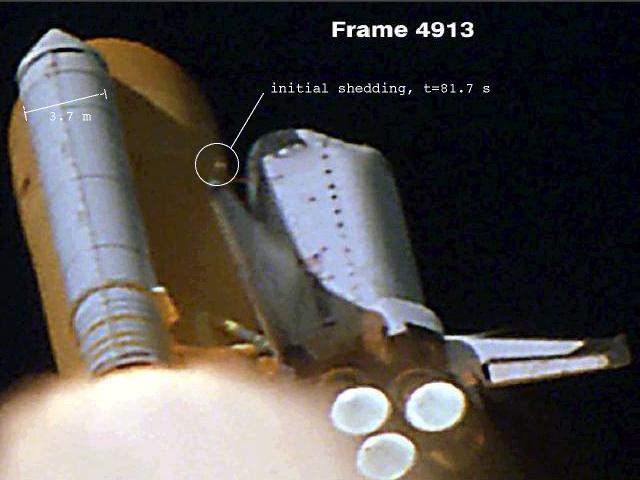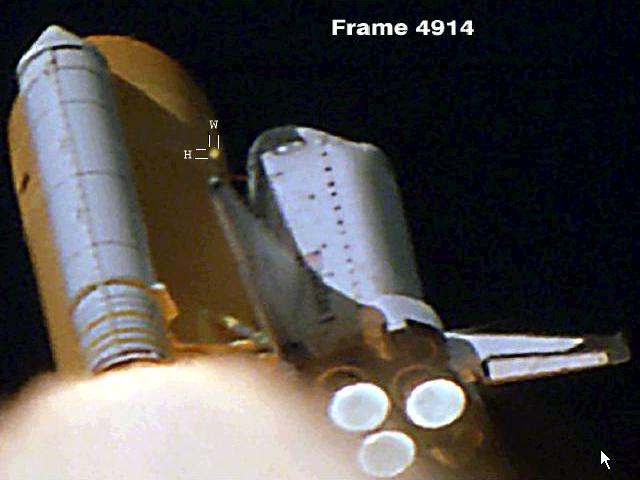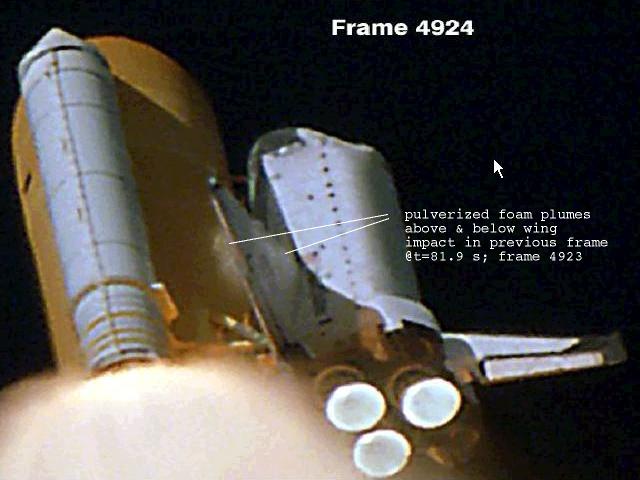 |
 |
 |
 |
 |
 |
 |
 |
 |
 |
 |



A Somewhat More Refined Engineering Estimate of the Foam Strike in the Columbia Accident on 01 Feb 2003
Preface for the reader: Engineering estimation seems to have become a lost art, gone when slide rules disappeared. Nevertheless, it is a useful skill to cultivate, since one can quickly get a handle on a problem that comes surprisingly close to the final result using the simplest of tools, such as a wristwatch with a second hand, a scribed steel ruler, some basic physics, and less than a half-hour’s scribbling on the proverbial back of an envelope. When physicists estimate the parameters of a problem, getting within a factor of 2 or 3 is considered good enough. They only start to worry if they're off by an order of magnitude or two (factors of 10-100). Three orders of magnitude is where it would get embarrassing. I studied physics before engineering, so I have always viewed mechanical engineering as a form of applied physics, and bring that sensibility to my work. I'll work in SI units (M-K-S) since I despise U.S. customary units (slugs, feet, etc.) and unholy hybrids (kilograms-force, pounds-mass, and what the heck is a “poundal&3148;, anyway?). My estimate is shown in blue, while the full analytical result of the investigation board is in green. Finally, at the bottom is my original back o’ the envelope calculation, as published on the FPSpace listserver on 05Feb2003, very rough and very quick yet amazingly (to me) close to the true answer.
PROBLEM STATEMENT: When the killer foam fragment broke off the External Tank, the reported Shuttle speed, therefore the slipstream velocity, was 700 m/s (as compared to my original guess of 850 m/s). That's about as fast as a rifle bullet from a full-length cartridge. How much damage could it do? Should top NASA management have figured this out for themselves, and been worried sooner?
APPROACH TO THE PROBLEM: We'll estimate the mass of the foam, then do a balance of forces on the foam using the equation for drag force and calculate deceleration, then figure impact velocity of the foam projectile on the wing from estimated time of flight. Then we'll calculate the impact energy and compare it to other things.
GIVENS:
The dimensions of the foam, W and H, can be estimated by scaling from a known dimension in the second image above. The Shuttle was so far away from the camera that we can assume all the objects are in the same plane, i.e. no depth of field and no distortion due to perspective. The diameter of the Solid Rocket Booster is 3.7 m, so that makes the foam about 0.5 m on a side. The minimum thickness of the foam on the External Tank was 1 inch or 0.025 m, but was thicker on the bipod ramp. Examining the first image in which the foam is just peeling away, a tenth of a meter seems reasonable thickness.
From various foam bits and wine corks laying around the house, we can estimate the foam's density as 1/30th of water, or 33 kg per cubic meter. These days, ET insulation is actually made of three different closed cell foams, two polyisocyanurates, one polyurethane, depending on location. Having the dimensions of the foam and its density, we now get its mass: 0.83 kg.
The foam was only edge on to the slipstream at first. So, figure area = 0.5 m × 0.1 m = 0.05 m2. In peeling off, that tumbling foam would have exposed its flat side to the slipstream, briefly getting huge kicks, but the back of an envelope isn't big enough to calculate a situation that complicated.
From Mark's, we estimate the coefficient of drag for a rough rectangular object edge into the breeze as Cd = 1.25. Mark's tabulates values from 1.0 to 1.5 for various edge-on rectilinear shapes; I selected the middle value. OK, not everybody has a copy of this huge tome in their back pocket, or has memorized every one of its thousands of pages of teeny tiny print. We could just skip the research and say “1&3148;, and not be too far off.
It is a useful rule of thumb that the density of Earth's atmosphere drops off by a factor of 10 for every 10 miles (16 km) up. The reported shedding point was closer to 10 miles than my original guess of 10 km, so the air density, Greek letter rho was 1/10 of sea level. 0.1 × 1.29 kg/m3 = 0.129 kg/m3.
I originally estimated the time of flight from capturing 4 to 6 frames of real-time video off the air. American TV is known to broadcast at 30 frames per second. 6/30 gives 0.2 seconds, which happens to be correct. But I wasn't sure what the frame rate of the original surveillance video was - 24 or 48. In the images above, the foam chunk flew free for 11 frames, about 0.2 second at the higher rate. Because I wasn't too confident about this estimate, I used a distance method instead of time method to get final velocity. Superimposing what I saw on video against my scaled Shuttle drawing, the foam flew for about 20 meters before disintegrating near the root of the wing. (I originally thought the foam came off the ogive nose of the ET, not the bipod ramp, hence the greater original estimate of fall of 30 m. But all these differences seem to have cancelled out.)
FIND: impact velocity, impact energy.
SOLUTION
Also F = m × a,
therefore a = (1975)/(0.83) = 2380 m/s^2, or 240 gee. That's a lot, too.
delta v = SQRT[(d * a) / 2] = 150 m/s
v(0) relative to Shuttle = 0 m/s
Therefore, v(f) = 260 m/s, or 850 fps, about the speed of a bullet from an old-fashioned 45-calibre revolver, only this bullet massed a kilogram. No wonder we saw pulverized matter exiting below the wing.
--------------------------------------------
orbiter speed at shedding, V(slipstream) = 700 m/s
height of fall = 19 m;
density of foam, rho, = 1/30 water
time to strike, t, = 0.16 sec
[ERROR: speaker said impact speed was same as muzzle velocity of .22 bullet. No. Was same as old-fashioned Colt .45]
solved for v(final) = 238 m/s
solved for deceleration, a, = 1480 m/s^2
solved for mass of foam block, m, = 0.76 kg
--------------------------------------------
[in response to my own question at end of presentation - that NASA imagines itself as an engineering agency, not a science agency, but they're actually not very good engineers because O'Keefe continually repeated grossly wrong velocity, energy figures in Congressional testimony thru mid-February - Osheroff replied that low-level engineers did make the same calculations that he did, that I did, while Columbia was in orbit. But middle management refused to accept them or pass them up the chain. He said O'Keefe's advisors certainly should have figured out this estimate for themselves, but failed to, or failed to properly advise their boss. He actually used phrase "lack of intellectual curiosity"! (same as my 04Feb03 piece)]
Part N. First back of the envelope calculation estimating the physics of the foam strike in the Columbia accident on 01 Feb 2003 (as posted 05Feb2003)
To: fpspace@friends-partners.org[later note: if any of these people had worked for Douglas Aircraft, the phrase "all three hydraulic systems" would have triggered memories of the DC-10 crash at Sioux City, Iowa in 1990?]
From: Robert G Kennedy III
Subject: ballistic foam
Cc: [snipped]
Bcc:
X-Attachments:
From the AP Newswire article by Marcia Dunn
>The investigation into the Columbia disaster is focusing on the possibility
>that a 2 1/2-pound, 20-inch chunk of foam insulation from the shuttle's
>external fuel tank fell off during liftoff and hit the left underside of the
>wing, causing damage to the thermal tiles that doomed the ship.
Years ago, when doing industrial robotics for Douglas Aircraft, some people I knew in Huntsville showed me their proposal for roboticizing that process of coating the external tanks. I'd heard tell that the insulation is shredded cork plus some binder which is sprayed on.
At the point where the foam was shed, the slipstream was going by the Shuttle at 1500 mph, or 2800 fps. That's as fast as a rifle bullet from a full-length cartridge. How much damage could it do? Let's try some high-school physics. I'll convert to m-k-s units.
GIVEN:
Estimate the coefficient of drag for a wide rough plank edge into the breeze as C-sub-d = 1.25
[Ed.Note: Mark's tabulates values from 1.0 to 1.5 for various rectangular objects edge on in the wind; I selected a middle value]
Air density drops off by a factor of 10 for every 10 miles (16 km) up. Based on the quality of the video, and knowing the slipstream velocity, I'm gonna guess the height where the foam broke off was about 10 km, so air density was between 1/2 and 1/4 sea level. Let's say 1/3, or rho = 0.4 kg/m^3
Velocity = 850 m/s, more or less.
Assume the foam was 5 cm thick and only edge on to the slipstream, that's 0.5 m x 0.05 m = 0.025 m^2 area. In peeling off, though, that tumbling foam would have exposed its flat side to the slipstream, briefly getting huge kicks.
Mass = 1 kg, more or less.
Assuming 24 frames/second video rate, that chunk was airborne for 4 to 6 frames, about 1/6th - 1/4th second. I'm not too confident about this estimate though, so let's try another method and equation instead. Superimposing what I saw on video against my scaled drawing of the Shuttle, that chunk flew for a good 30 meters before disintegrating against the wing. Frankly, I thought the foam chunk was quite a lot bigger than half a meter, at least the size of the lefftmost cockpit window, but I'll take NASA's word for it.
FIND
impact velocity, v(f).
SOLUTION
1/3%
Drag force = C-sub-d * rho * V^2 * A / 2, or 4500 newtons. That's a lot.
Since F = m * a, then a = 4500 m/s^2, or 450 gee. That's a lot, too.
delta v = SQRT[(d * a) / 2] = 260 m/s
v(0) relative to Shuttle = 0 m/s
Therefore, v(f) = 260 m/s, or 850 fps, about the speed of a bullet from an old-fashioned 45-calibre revolver, only this bullet massed a kilogram. No wonder we saw pulverized matter exiting below the wing.
During the lecture I mentioned the resolution of a spysat: the equation which describes the separation of two objects just barely resolved according to the Rayleigh Criterion is: 1.22 lambda x range / aperture
for lambda, take the middle value in the visible range, yellow light 555 nanometers
spysats are typically in 400 nautical mile polar orbits, or 700 km
one of the requirements imposed on the Space Shuttle's design by the military was an ability to haul spysats into space. Therefore we can take the width of the Shuttle bay as the limiting dimension for a spysat's optics, or 4.3 meters
Result 6 cm in visible light
the hole in the wing was at least 30 cm, so this would have been visible
1650 mph = 738 m/s
t(0) = T+81.7 sec
t(f) = T+81.9 sec
v(f) = 625 - 840 fps = 190 - 256 m/s (best before acc 213 m/s, after 238)
x = 12 - 18 in
y = 21 - 27 in
NASA analysis "day after launch"
RCC impact energy spec not to exceed 0.006 foot-pounds (= 0.305 m * 4.45 N) = 0.008 N-m [kg-m^2/s^2] compared to (0.76/2 kg * (190 - 256 m/s)^2) = 13700 - 24800 J, or 3 million times greater
rho = 0.038 (I said 0.033)
m = 0.76 kg
dim: 0.48 x 0.29 x 0.14 m
Gee, "Russian roulette" must be a safe game because I haven't killed myself yet
my reasoning occurs on p.14 end 1st para; p.60 (box); p.97 para 4;
REQUIRED SLIDES
- 5 metrics that were outside the envelope
longest time on the pad of any stack (38 days)
oldest ET (>3 yrs)
heaviest rainfall on any stack (>30 cm)
this orbiter had >80% of impact issues
foam chunk 4 orders of magnitude beyond Crater database
- Board org & makeup
13 members, 120 investigators/staff, 400 NASA engrs, 25,000 volunteers
- 5 independent analytical methods point to foam strike as prime cause
aerodynamic, thermodynamic, sensor data timeline, debris reconstruction, imaging evidence, plus later full-up impact test with flight hardware
- CAIB's recommendations for *before* RTF, org causes *equal* to tech
org fixes:
indep tech authority w control over reqs & specs & waivers
indep safety org w line authority over all levels of safety oversight
org culture to adopt best char of learning orgs
tech fixes:
prevent loss of foam off ET
better imaging of ascent
on orbit inspection & repair of TPS (already blown)
other recs are after RTF, continuing to fly
- Kalpana was a customer of mine
what the future holds
---------------------
RTF already slipped twice (May04-->Nov04, Nov04-->Mar05) now will slip again due to hurricane.
other problems
--------------
bolt catcher (bolts are 66 lbs ea)
cultural causes
---------------
careerism
team playing
groupthink
corporatism (USA redefined FOD to maximize award fee)
My Errata
---------
drifting object 2003-003B on Day 2 reentered on Day 5
$300 million for search, >$100 million for CAIB
bolt catchers; 4 separation bolts per SRB inc 1 big one at top
ET does carry everything
Orbiter held on with 2 struts at bottom and 1 bipod at lower edge of interstage under nose
most foam 1 inch thick
p.53: "despite commonly held perceptions, numerous tests show that moisture absorption and ice formation in the foam appears negligible"
p.55: "F3.2-3 Foam loss from the ET is unrelated to the tank's age and to its total prelaunch exposure to the elements. Therefore, foam loss on STS-107 is unrelated to either the age or exposure of Tank 93 before launch."
RCC has 20-40 thousandths of silicon carbide
Panels 7,8,9,10 had expected life 89,62,50,54 missions - what a bitch to hit the shortest ones! and the one exposed to highest reentry temps 3000F!! Murphy!!!
ballistic coefficient is sectional density [kg/m^2]
reentry aero force at loss of control was only 80 psf compared to 700 psf on ascent
true cost of the Columbia accident:
(US$M) item
----------- ----
$ 20 investigation
300 recovery
2000 orbiter
110 20% lost science from mission
16,300 human spaceflight budget, 2.33 years @ $7?B/yr
10,000 S.L. depreciation of underutilized incomplete Station in space, 2.5 years @ $4B/yr
3750 opportunity cost of uninstalled hardware on ground, 2.5 years @ $30B x 5% /yr
----------
32,480 total
[CAIB2003] various Columbia Accident Investigation Report, Volume 1, The, (US GPO: 2003).
[Marks1978] Mark's Standard Handbook for Mechanical Engineers, Eighth Edition, edited by Theodore Baumeister, McGraw-Hill Book Company, New York, 1978.
[TRW1991] ed. Thompson, Tina, TRW Space Data, (Thompson Ramo & Wooldridge, circa 1991)
[pad1995] various, Reporter's Space Flight Note Pad, (NASA, Feb 1995)
 Robert Kennedy is president of the Ultimax Group Inc., a corporation distributed across 11 time zones from Moscow to L.A. He speaks enough languages to start bar fights in all of them. Robotics engineer, amateur historian, and jack of all trades, he spent 1994 working for the House Science Committee’s Subcommittee on Space as ASME’s Congressional Fellow. On the Sputnik anniversary in October 1997, he managed to make the Russian evening news. Robert telecommutes from Oak Ridge, Tennessee, where he resides with his wife and numerous cats.
Robert Kennedy is president of the Ultimax Group Inc., a corporation distributed across 11 time zones from Moscow to L.A. He speaks enough languages to start bar fights in all of them. Robotics engineer, amateur historian, and jack of all trades, he spent 1994 working for the House Science Committee’s Subcommittee on Space as ASME’s Congressional Fellow. On the Sputnik anniversary in October 1997, he managed to make the Russian evening news. Robert telecommutes from Oak Ridge, Tennessee, where he resides with his wife and numerous cats.
Back to Directory of White Papers

For product or dealer inquiries within the USA & Canada, call:
West Coast: (888) ULTIMAX..................................................................East Coast: (800) ULTIMAX
Outside USA: +1 (865) 483-7097 -- note area code has changed from (423)
or send us a fax: +1 (865) 483-6317 -- note area code has changed from (423)
or write to us:
The Ultimax Group, Inc.
112 Mason Lane
Oak Ridge, Tennessee, USA 37830-8631
or send email to robot at ultimax dot com
The entire content (images and text) of these pages is copyrighted and may not be distributed, downloaded, modified, reused, re-posted or otherwise used without the express written permission of the authors.
Privacy Policy: The Ultimax Group Inc., will never sell our customer list or distribute our customer's personal data to others without permission.
These pages last updated July 1, 2005